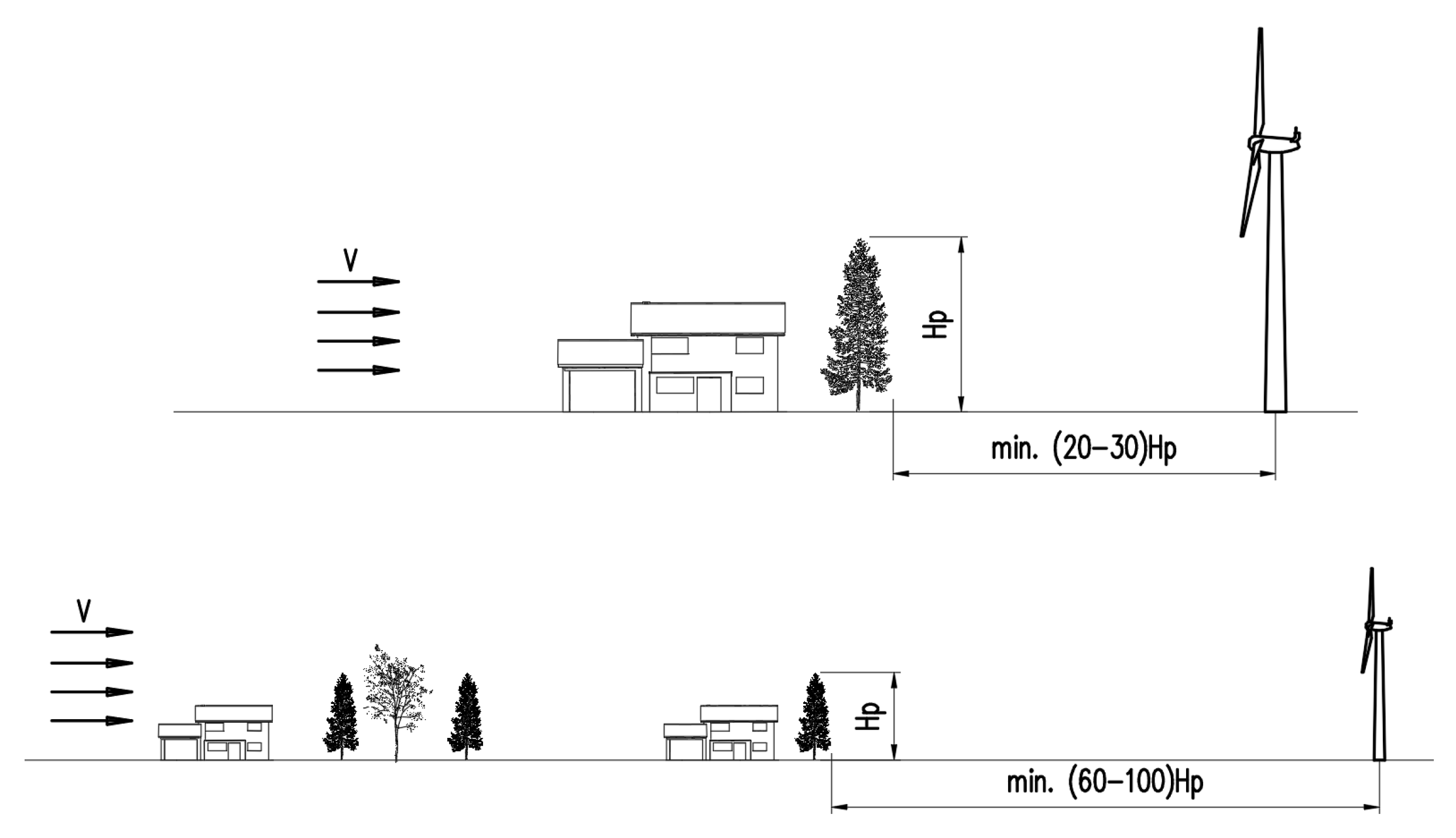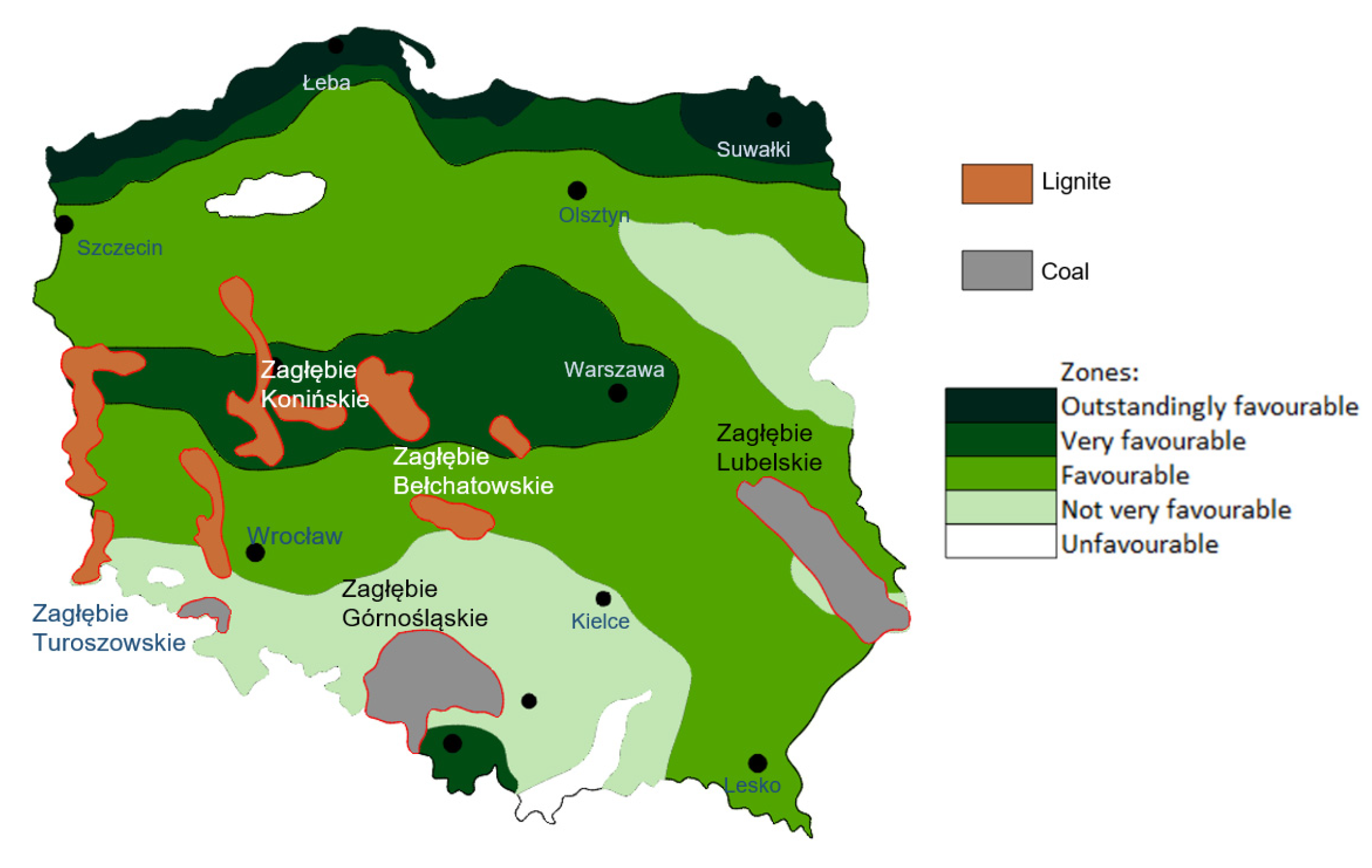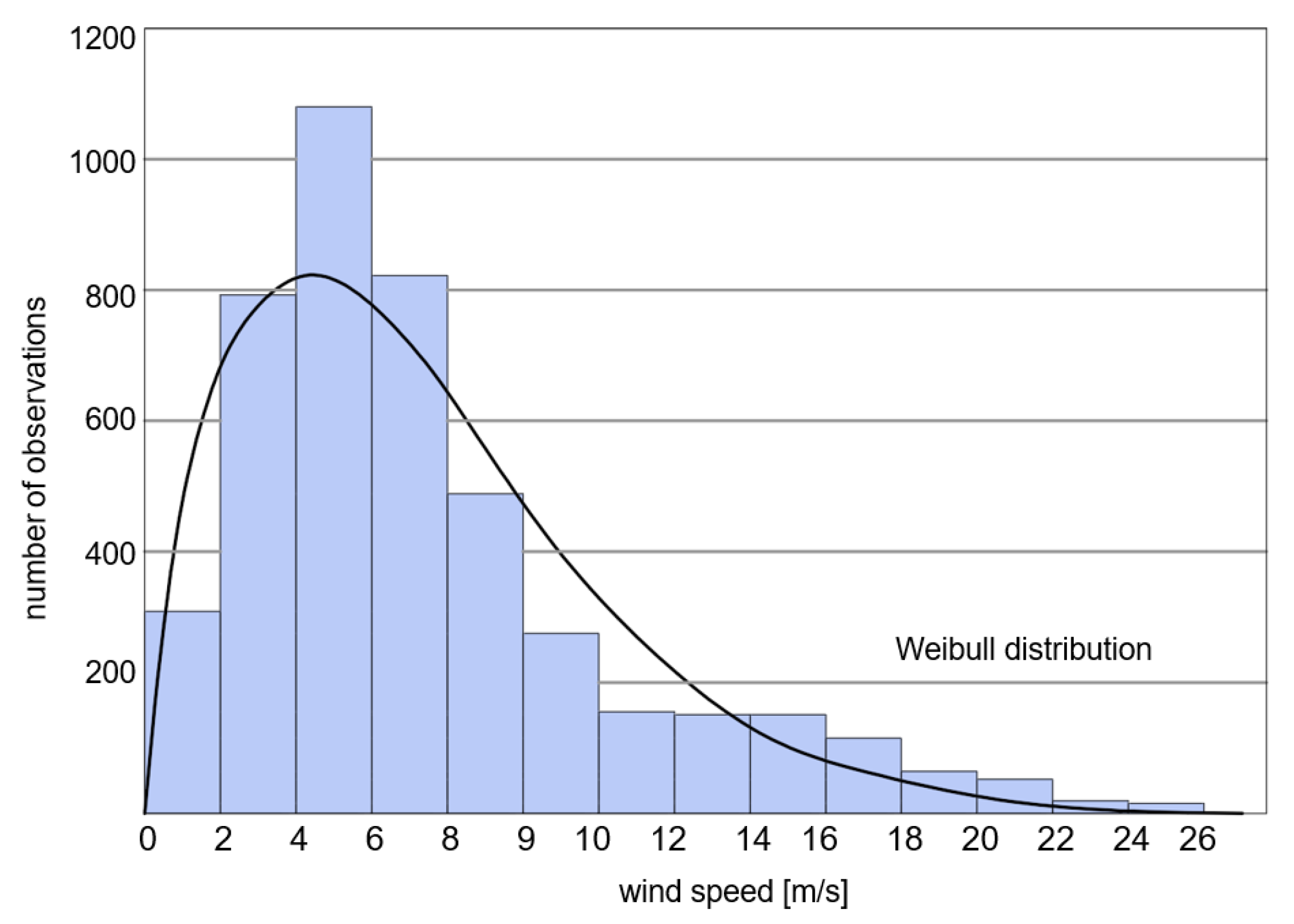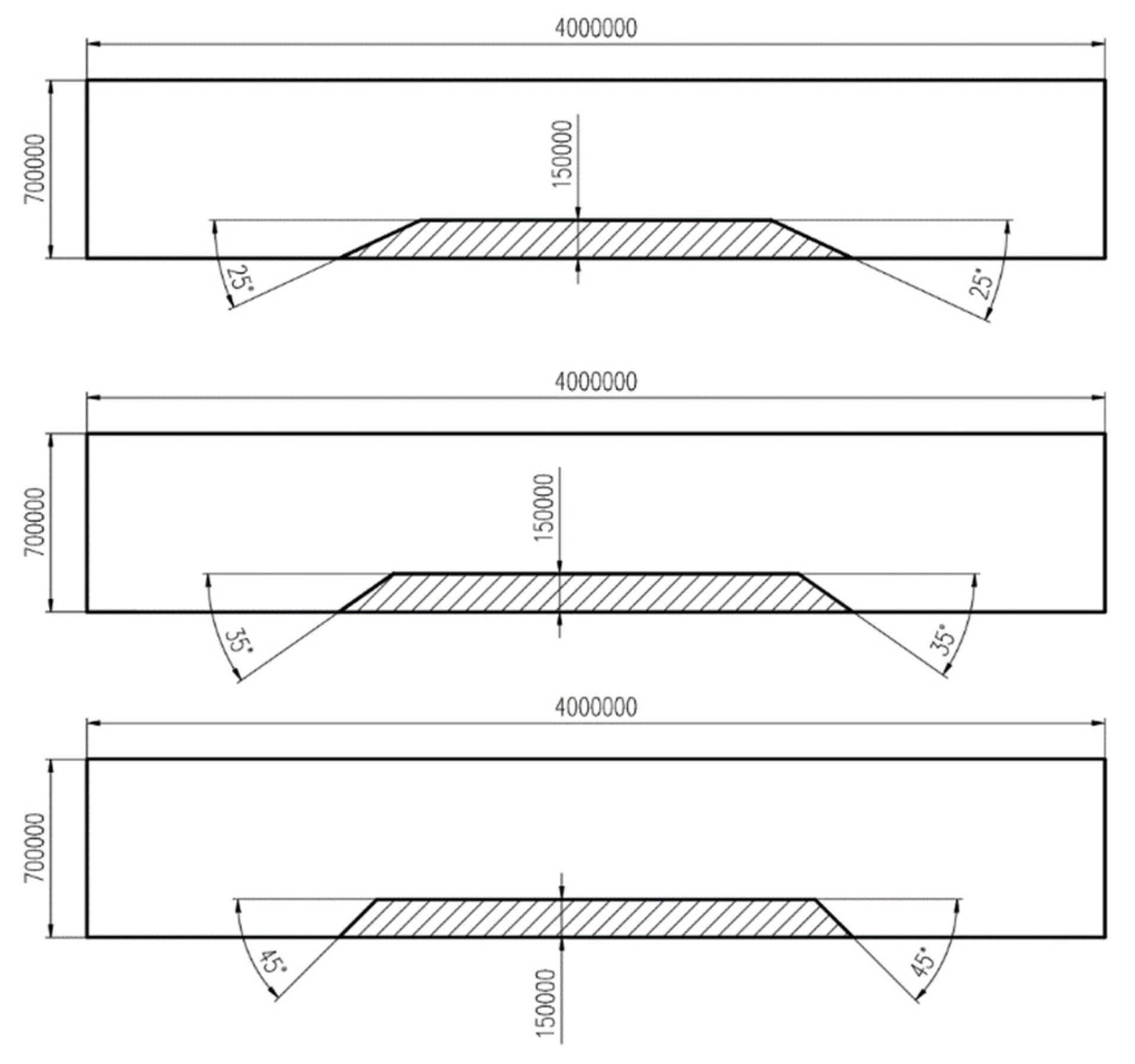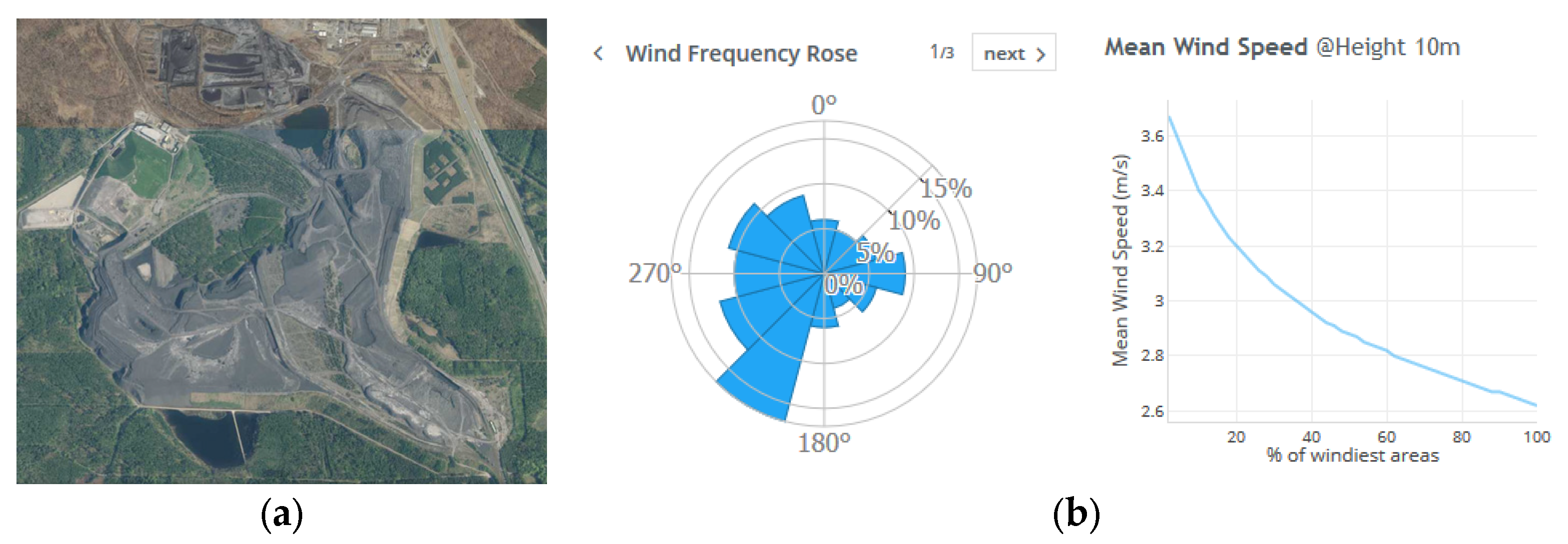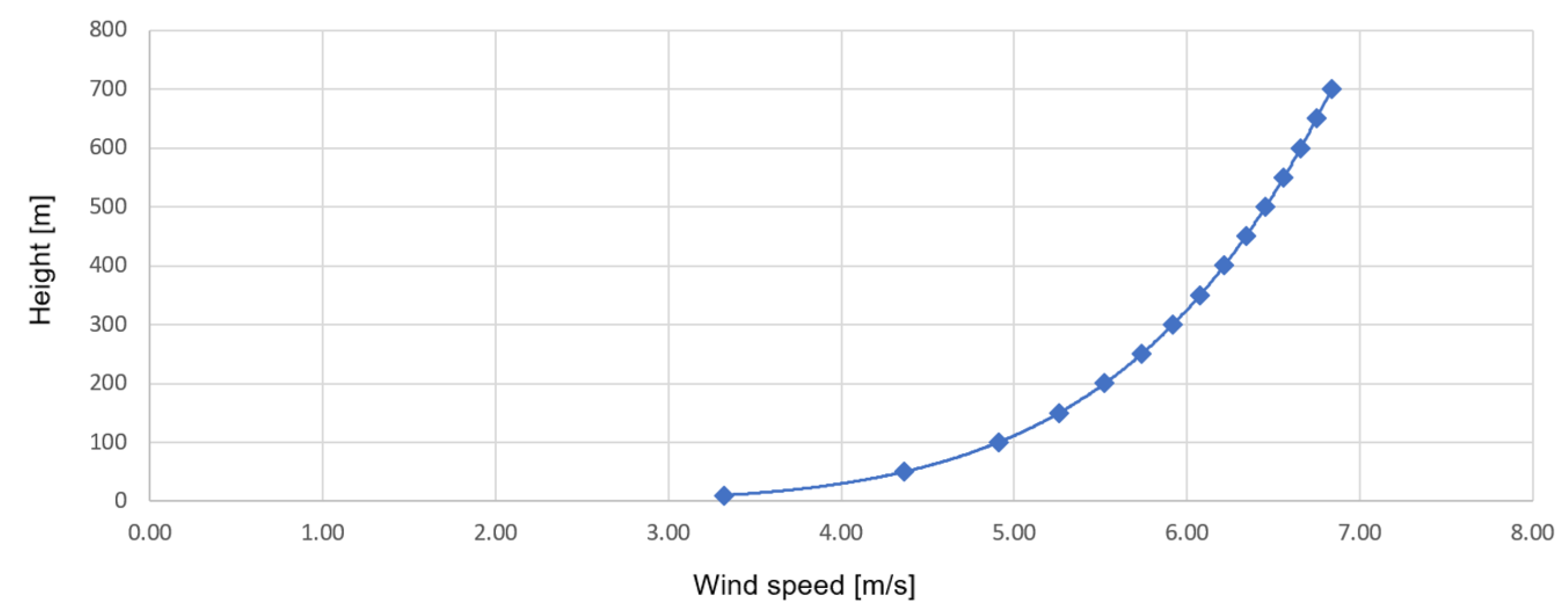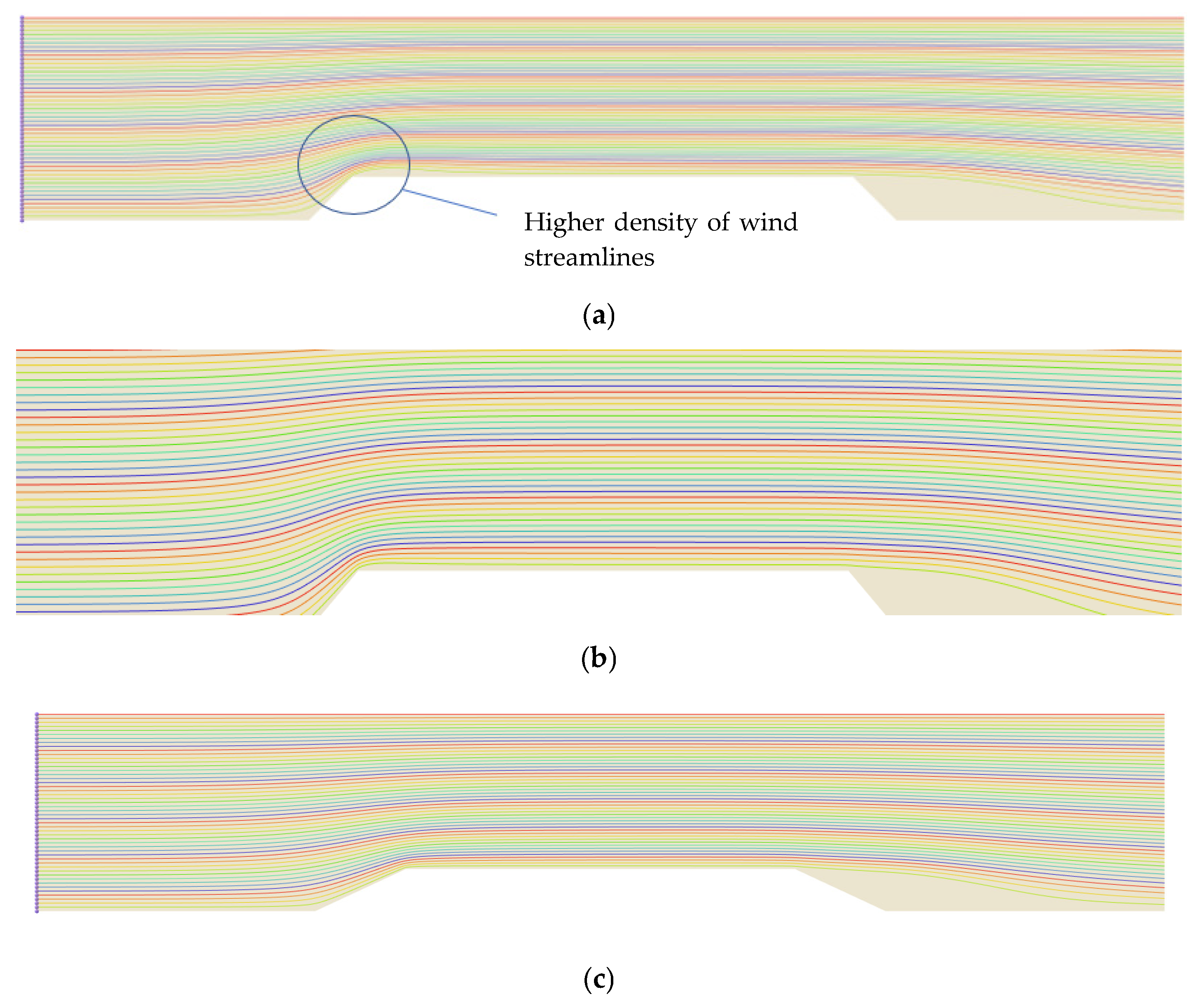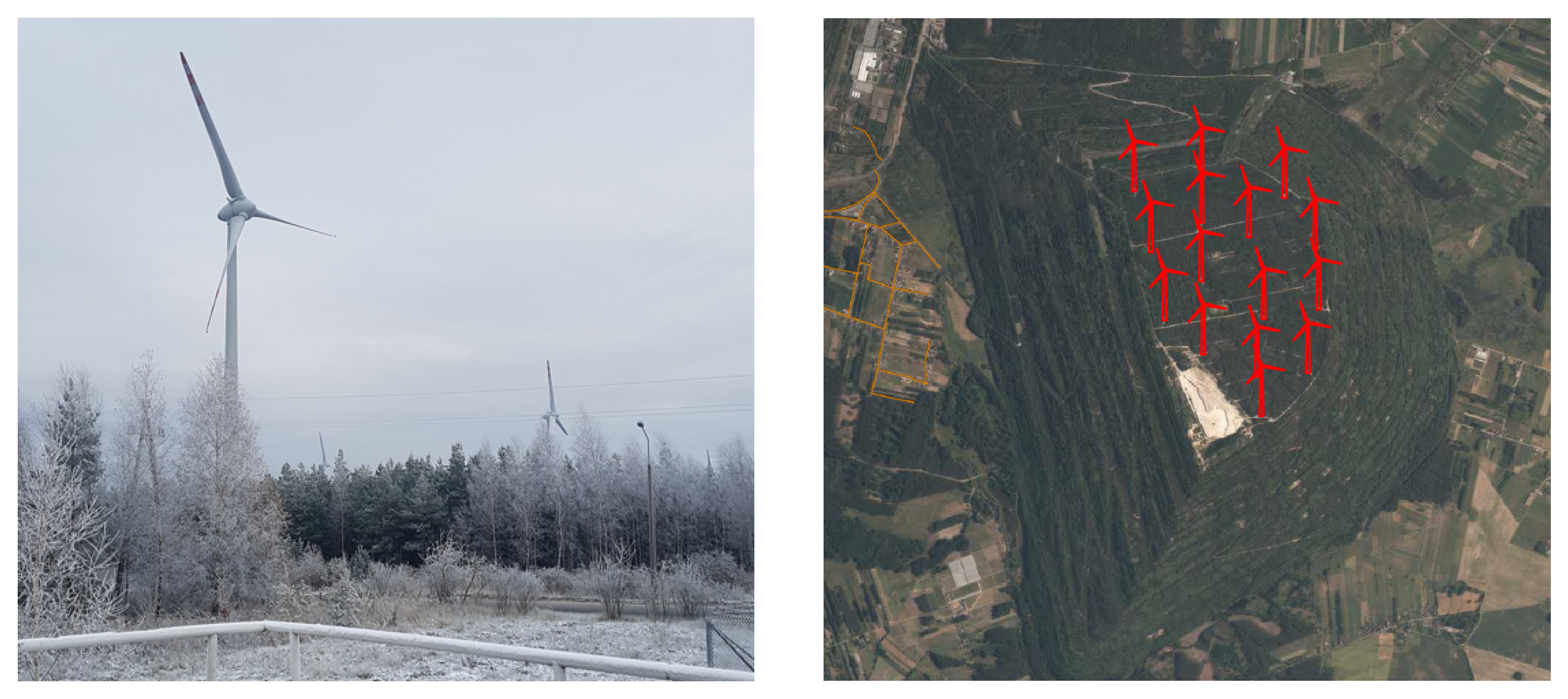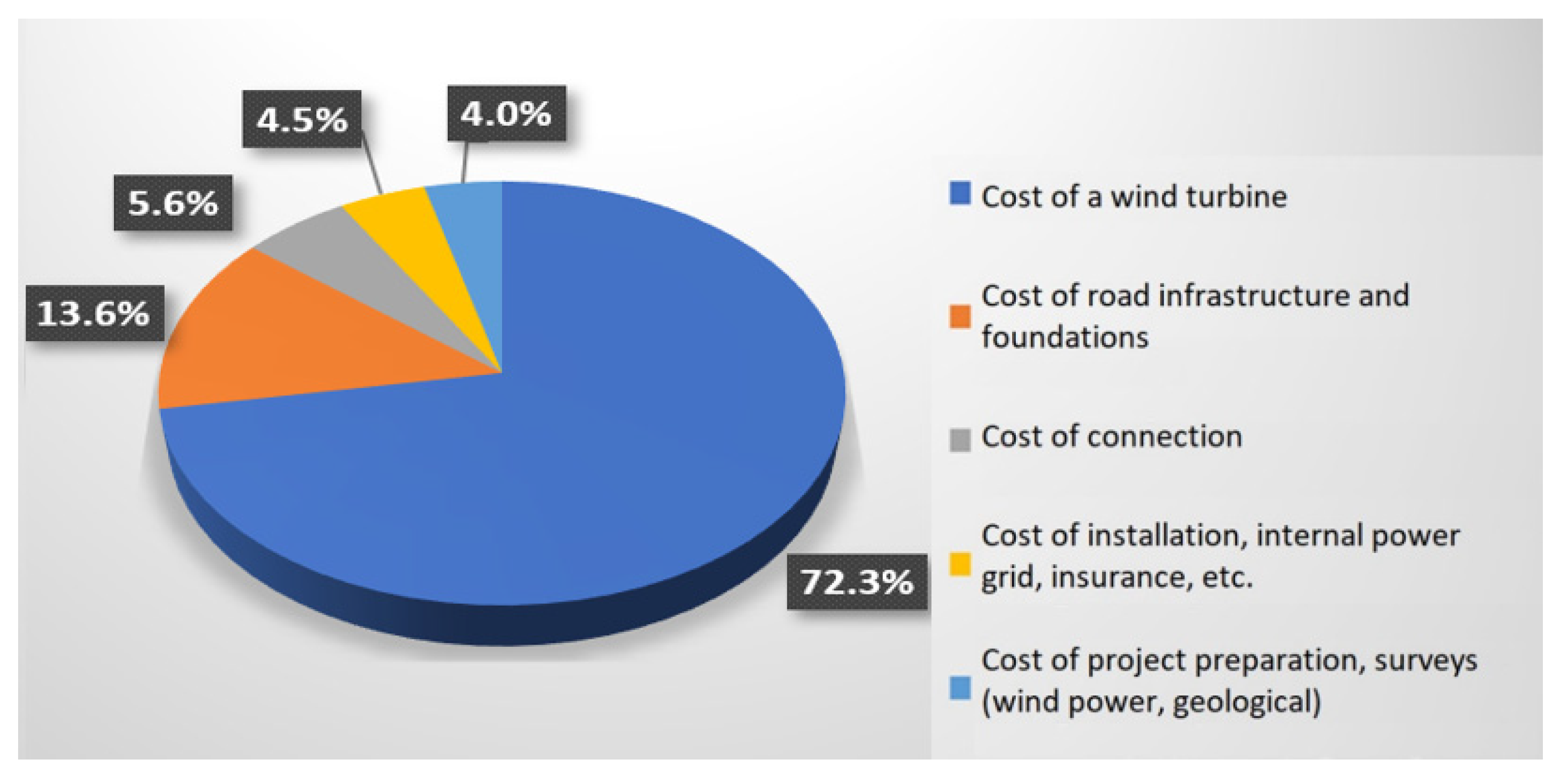1. Introduction
Over the years, it has been observed that, due to economic growth, energy demand is constantly growing. The consequence of such a situation is an increase in demand for traditional fossil fuels (oil, gas and coal) which are the main sources of energy. This is in contrast to the Green Deal, a strategy for climate neutrality planned as a goal for 2050 [
1]. A reduction in CO
2 emissions can be achieved by increasing the share of renewable energy sources (RES), in particular photovoltaic and wind power plants, in the energy mix.
In Poland, the Act of 20 May 2016 (Journal of Laws 2016, item 961) on investments in wind farms, the so-called Windmill Act [
2], is the document that defines the conditions for constructing wind farms in the vicinity of existing or planned residential buildings. The Act does not apply to investments implemented and used in the coastal areas of the Republic of Poland.
The Wind Farm Act in its current form has a negative impact on the development of wind energy in Poland. In light of the new regulations in Poland, it is profitable to build wind farms only at sea, because those constructed on land are subject to restrictions (99.7% of Poland’s area has been excluded from the possibility of investing in new wind farms with high power) [
3]. The Act, introducing restrictive criteria regarding the distance of wind farms from buildings and protected areas, amounting to at least 10 times the height of the windmill, resulted in the fact that new farms may be built only in an area of about 1% of Poland’s territory (legislative work is currently underway to change the provisions in the Wind Farm Act). The beliefs rooted in social consciousness about the allegedly harmful impact of wind farms and concerns about the loss of the market value of the land near the wind farms have an additional negative impact on such investments. The use of post-mining areas may be the solution to the deficit of land for wind energy. The advantages and disadvantages of using artificial hills, such as mine waste heaps, are considered [
4,
5,
6,
7]. Mining waste heaps are mainly heterogeneous waste material, piled up in a conical or irregular shape with a high profile in relation to the local topography [
8,
9,
10]. The typical height of the heaps varies from 30 m to 100 m, and the inclination of the slopes is usually from 20° to 40°. In such cases, the benefits for wind energy are seen in the increased land elevation, and these artificial hills, as landfills, are usually not attractive for the construction of buildings.
An example of a wind farm built on a heap is the 30MW wind farm built in Poland on the “Góra Kamieńsk”.
2. Analysis of Wind Conditions in the Mine Waste Areas Based on the Data from Meteorological Centres
On the basis of long-term observations of wind parameters by the Institute of Meteorology and Water Management, the wind map of Poland is created and continuously updated (
Figure 1) [
11]. It includes the division of the country into areas of different wind conditions marked by different colours, indicating which areas are favourable or not for the location of wind farms.
It can be observed that the wind conditions are arranged in horizontal stripes running through the territory of Poland (
Figure 1). By far, the most favourable conditions for the location of large wind farms, aimed at the production of electricity for commercial purposes, are found in the central, northernmost part of the coast and in the Suwałki Region. Slightly worse, but still quite favourable regions are the central parts of the country, the Silesian Beskids, the Żywiecki Beskids and the Bieszczady Mountains.
For small home power plants, the observations were made at lower altitudes. Based on the observations, it can be concluded that the production of energy using small wind farms under local wind conditions may also prove to be a cost-effective solution in areas classified as unfavourable due to wind conditions. For the start-up of smaller turbines, especially those with a vertical axis of rotation, significantly lower wind speeds are sufficient than for turbines with a power of several megawatts [
12].
The main factors limiting the use of wind energy are the following:
Average annual wind speed—at low wind speeds, the payback time for the construction of a wind turbine is too long and may exceed the life of the facility;
Terrain—flat areas or hills with a slight slope are the best.
The wind speed (
V) increases with the elevation above the terrain up to the elevation when it becomes constant. The distribution of wind speed with height is determined by the power function, on the basis of experimental material, in the following formula [
12]:
where:
V10—wind speed at height H = 10 m above the ground;
H—height over the ground;
α—factor depending on land type and buildings, determined experimentally.
The following three types of land can be distinguished:
The abovementioned three-level classification is used for overhead structures and buildings. In Poland, for the purposes of wind energy, six roughness classes and the corresponding power exponent α are suggested (
Table 1) [
13].
An analysis of the land roughness allows experts to determine the optimal position for the wind farm, as shown in
Figure 2.
Taking into account the wind conditions in the areas of mining heaps, it can be concluded that the best conditions for the construction of wind farms are in the Konin Brown Coal Basin (Zagłębie Konińskie), and slightly worse conditions are in the Bełchatów Coal Basins (Zagłębie Bełchatowskie) and Lublin Hard (Zagłębie Lubelskie). The Upper Silesian Basin (Zagłębie Górnośląskie) has the worst wind conditions (
Figure 3).
The wind speed at high altitudes (100 m and above) is similar over a large area. The land profile affects the wind speed [
14]. The use of artificial hills, such as mine heaps, may improve the performance of wind farms. In such cases, the shape of the heap (slope) may be important.
3. Wind Speed Measurements for the Requirements of the Wind Power Industry
The expected wind energy of a site intended for constructing wind farms can be estimated on the basis of the “wind atlas” [
15]. Due to the fact that the data contained in such atlases present averaged values related to a given area, they may not take into account local changes in terrain conditions, such as artificial hills (heaps). Such elevations change the wind conditions by increasing the ram effect and allowing access to the upper atmosphere. In such cases, it is advisable to estimate the local windiness via in situ tests. Such measurements are taken using the calibrated wind speed and wind direction sensors placed on the measuring mast. In addition to these basic parameters, air humidity, temperature and pressure are also recorded, which are needed to determine the air density and the sensitivity of the location to icing.
Measurements of the wind direction and speed for the purposes of wind energy determination should be taken on a mast not lower than 75% of the height of the turbine rotor axis for which the wind farm is designed, if it is not possible to take measurements at the height of the turbine axis. In addition, the measurement of the wind speed should be taken at several heights [
16]. The sensors should be properly located in relation to the prevailing wind direction, so that the aerodynamic shadow caused by the mast structure has the smallest possible impact on the error of estimating the wind potential of a given location [
17,
18]. SODARY (sound detection and ranging) devices [
19] are an alternative solution to measuring masts.
On the basis of the measurement data, it is possible to develop the wind speed distribution within a year, and as a result, to forecast the energy production of the given wind farm. The dominant wind direction is additional information obtained from the wind measurements. This is important when planning the location of wind turbines in the area of the future wind farm.
The data obtained from the tests are grouped according to each speed range. The frequency distribution of a given wind speed may be presented graphically in the form of a histogram (
Figure 4). It is created by summing up the number of wind speeds n in a given wind speed range.
The frequency
fi of the occurrence of a given range of wind speed (
ni) is determined from the following relationship:
where
N means the number of all measurements taken in the given period.
The frequency
fi can be interpreted as the probability of wind in the
i-th speed interval. Referring to the basic measurement period (marked
T), which is one year, it is possible to determine the duration (
ti) of the wind using the average speed vi during one year:
The wind speed histogram is interpolated using analytical functions. The nature of the wind speed distribution is best reflected by the following Weibull function:
where
A and
k are the parameters determining the function shape.
The correctly selected parameters
A and
k indicate that the average speed and gross wind energy calculated from the Weibull distribution will be equal to those calculated from the histogram (
Figure 4).
The average wind speed results strictly from its distribution described by the probability density function. The histogram shown in
Figure 4 is an approximation of this function. Using the calculations made while plotting the histogram, it is possible to determine the average wind speed
Vav according to the following relationship:
where:
However, the average speed is not the most important factor determining the suitability of a given site for the construction of wind farms. This is due to the fact that with the same average wind speed, the speed distribution may have different shapes—the share of speeds with low or high values will be different. Therefore, it is necessary to analyse the energy efficiency of wind and energy production by a specific type of wind power plant for the given wind conditions. For this purpose, when analysing the histogram, the characteristics of the operation of the wind power plant should be taken into account. These characteristics determine the correlation between the power of the power plant and the wind speed. The starting speed of the wind farm, i.e., the speed at which it is switched on, is given in these characteristics. It usually varies from 2.5 m/s for small structures to about 4.5 m/s for more powerful generators. The shutdown of the plant usually takes place at a wind speed of about 25 m/s. For small power plants, the shutdown speed may be higher [
12,
14].
4. Analysis of the Mine Heap Shape’s Impact on the Wind Cross-Section Profile
An elevation such as a heap is an obstacle for the wind, forcing its flow to the sides and to the top. Wind blowing perpendicular to the slope base rises when reaching the obstacle and flows over its top. An obstacle along the path of the wind reduces the vertical cross-section of the flow by its height. According to the law of fluid flow continuity (Bernoulli’s law), the same amount of air must flow at the same time as before; therefore, the flow velocity will increase, compensating for the reduction in the vertical section.
Whether the flow over a hill, such as a mine heap, will be laminar or turbulent depends on the terrain roughness and the inclination angle of the heap. For this purpose, numerical simulations were performed using the HyperWorks program.
The computational model recreated and discretized the area surrounding the mine heap. Four layers of wall model components were defined, and then Air as a material with typical (default) parameters defined using the HyperWorks V14 software was assigned. In addition, an Inlet was defined on the left side of the model (
Figure 5) on a vertical plane. The average air velocity was assumed as the boundary condition, and it was similar to the wind conditions in the vicinity of the KWK Szczygłowice mine heap (
Figure 6). An Outlet was assumed on the right side of the model. Air could flow freely through it without resistance. In simulations, the Spalart–Allmaras turbulence model was used. The model was prepared in three versions. In each of them, the heap had the same assumed elevation equal to 150 m. For each version of the calculation model, different slope inclinations, i.e., 25°, 35° and 45° (
Figure 5) were assumed.
The cross-section profile of the wind flowing onto the slope of the mine heap was determined from the relationship (1).
Based on satellite images, the roughness was assumed as class 3 terrain level (woodland, city suburbs), for which the coefficient is α = 0.17. The wind speed, depending on the elevation assumed for the simulation, is shown in
Figure 7.
The results of the simulations for the above assumptions performed using the HyperWorks program are shown in
Figure 8.
The accumulation of lines on the edge of the upper slope, under the pressure of the wind, is observed in the analysis of the wind streamlines’ distribution. The greatest accumulation is in the heap with the greatest slope angle (45°). The analysis of the streamlines at the flattened surface of the heap top shows no differences in their trajectories. For more information, see the wind contour maps (
Figure 9). On the wind speed contour maps, different speed zones behind the top edge of the heap can be seen. The greater the slope inclination of the heap, the more areas of different speeds are present, which indicate the presence of air turbulence in these places, and thus unfavourable conditions regarding the efficiency of a future wind power plant installed there. Based on the contour maps for the considered example, it was estimated that the elevations of this turbulence area for the slope angles 25°, 35° and 45° are, respectively, 23 m, 43 m and 102 m. From the wind speed contour maps, it can also be observed that an artificial elevation such as the mine heap caused an increase in wind speed (above 7 m/s), not observed in front of the hill. Additionally, the greater the slope angle, the greater the area of the increased wind speed, parallel to the ground, that is available at a greater height and further away from the upper edge of the slope. For example, for a slope with a 25° inclination, it was found at a height of 76 m at a distance of 432 m from the edge, and for a slope with a 45° inclination, it was found at a height of 90 m at a distance of 939 m from the edge of the slope. The vectors of wind speed are presented in
Figure 10,
Figure 11 and
Figure 12.
5. Experience of Constructing Wind Farms in the Areas of Mine Heaps
The wind farm on the Góra Kamieńsk artificial hill [
21,
22] is a positive example of using mine heaps for the construction of a wind farm.
Figure 13 shows the view of the wind farm. Two-year measurements of wind parameters were the first stage of planning the investment. Then, on the basis of the analyses, the energy potential of the wind was determined, and using this information, the spacing of the turbines on the mine heaps was optimised. An expert opinion on the impact of the connected power plant on the power grid and an environmental impact assessment of the power plant were also prepared. The problem was to make proper foundations for each pylon of the power plant in relation to the geological conditions found on the mine heap. Difficulties also appeared during the transport of large-sized components of the power plant. The wind farm consists of 15 Enercon E-70 windmills with a height of 85 m and a wind turbine diameter of 70 m. The nominal power of the plant is 30 MW (2 MW per wind turbine). These types of power plants are gearless systems—the wind turbine directly drives a low-speed synchronous generator. The rated power (2 MW) is reached at a wind speed of 12.5 m/s.
A long-term analysis of the wind farm operation shows that over the years, from 2011 to 2019, it operated with an average power of 25.3% of the maximum power on about 330 days a year. These are very good operating parameters, undoubtedly affected by the place where the farm was built, in this case the mine heap. The operation of the wind farm allowed for the production of approx. 60 GWh per year at an average wind speed of approx. 6.3 m/s (
Figure 14).
6. Investment Outlays for the Construction of a Wind Power Plant in the Area of Mine Heaps
Observing the changes in the cost of building a wind power plant, a significant reduction in the cost per 1 MW of installed power can be noticed. According to the calculations of organizations such as Ernst & Young or TPA Horwath, the cost of a wind power plant decreased systematically from PLN 6.9 million in 2012 to PLN 5.9 million in 2019 [
23]. The investment costs of building a wind power plant are all the costs incurred during the preparation, designing, purchasing the components and constructing the installation, until its commissioning. The costs can be calculated from the following equation:
where:
KZ—purchase costs of the components for the wind power plant;
KIF—cost of infrastructure, construction of the wind farm foundation;
KWP—cost of connection to the power grid;
KIU—cost of installation, internal power grid, insurance during the construction work;
KPB—cost of the technical project, measurements of local wind conditions.
It is estimated that the structure of investment costs in the case of building a wind farm in Poland, per 1 MW of installed power, is as follows: the approximate cost of a wind turbine—77.5%; the construction of road infrastructure and foundations—7.3%; connection costs—6%. Other installation costs, building an internal power grid and insurance are 4.9%. On the other hand, the cost of the project preparation is about 4.3%, which includes the cost of developing the technical design, feasibility studies, environmental reports, wind force measurements, geological surveys, as well as costs of administrative proceedings.
The total cost, taking into account the cost of building a wind farm, calculated per 1 MW, is PLN 5.9 million. A breakdown of the expenditure into separate costs is presented in
Table 2.
With regard to the specific conditions for the construction of a wind power plant on artificial hills, created during the landfill of mine waste (heaps), two issues can have an impact on the increase in the cost of building a power plant in such a place. These issues are related to road infrastructure and foundations. In most cases, the roads leading to the top of the heap are unpaved roads made of material deposited on the heap. Due to the use of heavy equipment during the construction of wind farms and transporting large-size components, it is necessary to provide appropriate infrastructure. On average, for the construction of one foundation for a wind turbine, 500 m
3 of concrete and 60 tonnes of steel are needed, i.e., about 100 trucks with concrete and a dozen or so with a supply of reinforcement materials. The construction of access roads for the delivery and assembly of wind turbines should be preceded by an analysis of several basic conditions. They are defined for each investment based on wind turbine manufacturer guidelines, current road construction standards, service contracts with turbine suppliers, local land development plans, lease agreements with landowners, and finally, construction costs. The bearing capacity of the ground for the cars and cranes assembling the wind turbines is very important. It is also important to ensure good drainage of rainwater from the road surface. Cross slopes can be shaped on one or both sides, most often with a slope of 2%. For the assembly sites, transverse and longitudinal slopes are determined by the type of crane used, and for truck cranes, slopes from 1.5% to 2% are allowed, but for crawler cranes, the site should be shaped with slopes up to a maximum of 0.5% [
24]. With regard to the heaps, it is therefore necessary that the heap at the top has a sufficiently large flattening, enabling the deployment of infrastructure necessary for constructing the wind farm.
It is estimated that the costs associated with the construction of road infrastructure and foundations in the case of mine heaps may increase by up to 100%. The experience of building a wind farm on Góra Kamieńsk hill, where additional stabilization of the ground achieved via the use of gravel piles was required, confirms it. Additionally, the entire heap is monitored for subsidence. Measurements are taken once a year.
Considering the above, the cost of road infrastructure and foundations may account for as much as 13.6% of the total expenditure, and the total investment cost may reach PLN 6.3 million per 1MW of installed power (
Figure 15).
7. Conclusions
As a result of the end of mining activity in Europe, many landfills (heaps) were created, and only some of them have been revitalized and developed. These areas can be perceived as attractive places for investments for renewable energy sources. This issue was studied in the SUMAD project. Heaps are characterized by a large spectrum of diversity in terms of shape, type of material and land potential. One of the most frequently implemented methods of revitalization in these areas is the reuse of heap material, or making the area available for recreational and sports activities. The development of renewable energy sources observed in recent years has highlighted the new potential of these areas as places for the construction of PV installations and wind turbines.
Turbines operate correctly when the direction and speed of the wind are stabilized. These factors are negatively affected by the topography, defined by the roughness parameter, so in lowland areas of high roughness, wind turbine nacelles are placed on a high mast. Planning the construction of wind farms should be preceded by taking measurements of wind parameters, as well as by an analysis of the technical, legal and social conditions of such an investment. Wind conditions can be recognised on the basis of many years of measurements obtained by meteorological institutes and the wind maps developed by them. There is also online access to information about wind energy, such as the Global Wind Atlas, which allows us to additionally estimate the energy yield resulting from the wind parameters in a given area. Ultimately, before the construction of a wind farm, it is recommended to take wind measurements in the area of its location. Measurements obtained with the use of measuring masts are recommended to be taken at the height of the planned turbine rotor, and if it is not possible, at a height of not less than 75% of the height of the rotor installation. SODAR measurement systems that do not require the construction of masts are also available. The year-round results of wind power measurements allow us to determine the expected productivity and payback time.
The main feature that encourages the use of mine heaps for the construction of wind turbines is the artificial elevation of the land, which allows access to higher layers of the atmosphere, and thus better wind conditions. Heaps, as a landfill area for mining waste, are of no interest to residential or industrial construction. Perceptible difficulties related to the construction of wind farms result from the stability of the ground. Most often, the construction of wind farms in such areas will be associated with engineering works to strengthen the subsoil (dynamic, impulse soil compaction, gravel columns, etc.) Taking into account the location of wind turbines on heaps, it is necessary to analyse the impact of its geometric shape on stratification and wind direction. The location of the turbine at the edge of the heap, despite the advantageous high wind speeds, may adversely affect the operation of the turbine due to the turbulent air flow in such a place. Further research should be carried out towards selecting such numbers and arrangements of wind turbine masts in the heap area to maximize the energy efficiency of wind farms.

